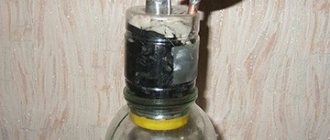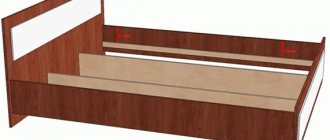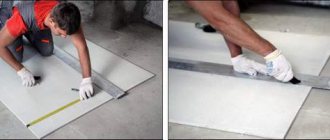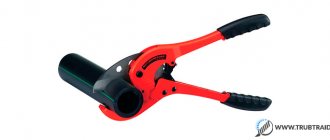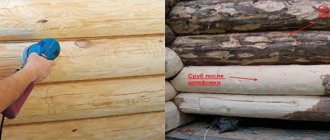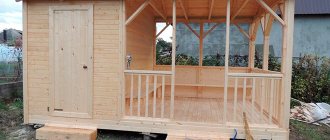In my work, I sometimes have to use laminated chipboards to fill niches, make shelves and custom furniture. I prefer to buy ready-made furniture panels in stores. They are available in several standard sizes, have factory edges, and if you adjust the future product to these dimensions, then assembly is quick and without problems. But it’s not always possible to do without cutting, so you have to think about how to cut the chipboard so that the cut is even and smooth, and chips do not form on the decorative surface.
Source tildacdn.com
How to cut chipboard
Laminated chipboard can be sawed with a hand saw with a fine tooth, a jigsaw, or a circular saw.
The cut area is taped with masking tape and cut along the cut line with a sharp knife. The knife cuts through the laminate and the top grain of the wood underneath. Further, when passing the saw, the chipboard will not chip. Finishing the end under a C-shaped overlay edging when making furniture, this method is quite suitable. And under melamine self-adhesive tape it is better to use another method. Using a jigsaw or circular saw, we cut the chipboard with a margin of 2-3 mm. from the cutting line. I sawed along the guide with a jigsaw. You can use any smooth strip or rule as a guide. In my case, fiberglass lath is 150 mm wide. thickness 4 mm. As described above, chips formed on the chipboard. Next, we set the guide exactly along the cutting line and remove these 2-3 mm with a hand router and edge cutter. which we kept in reserve. The design of the edge cutter has a bearing on the shank equal to the diameter of the cutter itself. As a result, we get a perfectly smooth edge, to which you can easily glue self-adhesive melamine tape. Also, when cutting curved cuts, you cannot do without using a router. Using a jigsaw, we make a guide with the required radii and also go through the end with an edge cutter. The method of cutting chipboard without chipping is also suitable for cutting laminated plywood and MDF.
If you have at least once tried to cut chipboard at home, then you know for sure that this work is by no means easy and requires not only skill, but also the availability of a good tool. Laminated chipboard is especially difficult to process; when cutting it, many chips often form. That is why many craftsmen, faced with such a problem, come to the conclusion that it is better to cut chipboard when purchasing, especially since many trading organizations provide similar services and the price is quite reasonable.
Chipboard sawing is carried out using precise format-cutting machines, which will help obtain workpieces of a given size and shape.
In addition to cutting sheets, they will help you calculate and provide in the form of a visual video file several options for competent and economical cutting of sheet material (using special computer programs) and, if necessary, perform edging. However, if for some reason you prefer to do this work yourself, you will have to do some preparatory work before cutting the chipboard.
Types of files according to cutting edge geometry
If you look closely at jigsaw files, you will notice that they all differ in the size of the teeth set and the geometry of the sawing edge. The more the teeth are set apart, the wider the cutting line will be, which increases the speed of work, although at the cost of reducing the quality of the cut. Not only the cleanliness of the cut depends on the wiring method, but also what materials this equipment can be used for working with.
Milled with classic layout.
Peculiarities . In files with a classic setting, the teeth are alternately bent in different directions, like in ordinary hand hacksaws. This arrangement helps to reduce the heating of the saw during operation, since the blade experiences almost no friction in a fairly wide cut. It is almost impossible to get a neat cut with such a file, but the work speed will be high.
Purpose . The purpose of saw blades with milled teeth and classic settings is to quickly cut hard and soft wood, as well as plastic and non-ferrous metals.
Milled with wavy layout.
Peculiarities . In equipment with such a layout, the teeth do not change direction one by one, as in the previous case, but in groups of several pieces. Moreover, each tooth has a different deviation from the central axis than its closest neighbors - the working edge of the saw blade forms a wave.
Purpose . The purpose of saw blades with wavy layout is to make a clean cut not only on wood, but also on chipboard or plywood, as well as working with non-ferrous metals and plastic.
Polished with classic layout.
Peculiarities . The teeth of such blades are set apart and undergo a grinding process. The cutting line of such blades is quite wide.
Purpose . Saw blades with ground teeth, set in a classic way, are designed for quick but relatively clean cutting of wood and its derivatives - chipboard, fiberboard, etc.
With conical grinding without routing.
Peculiarities . The blades of such saws do not have a tooth spread, but their segments are ground, which ensures a thin cutting line and an even cut.
Purpose . Allows for accurate cutting of wood, laminate, and polymer materials.
What affects the quality of chipboard cutting?
In this case, we will be sawing chipboard; this is the most capricious material for sawing, because it has longitudinal and transverse layers, and a rather delicate and thin veneer. But on the other hand, it has a hard adhesive base, which will also interfere with us.
Saw blade. How to choose it?
When cutting chipboard, the saw blade must simultaneously cut cleanly and be durable, because the properties of the glue are very close to glass and dull the tool itself quite quickly. Therefore, in the process of cutting chipboard, you need to choose disks that are good enough to cut with them without loss of quality for a long time.
What is the difficulty of sawing with a circular saw with discs?
If we look at the cut of the workpiece, we will see that it is full of burrs, because “by hand” it is practically impossible to guide the saw straight through the cut.
On the saw blade there is a difference in height between the body of the saw itself and the sawing part - the tooth. Due to this distance, the disc has the ability to direct its position in the cut. Accordingly, as soon as it changes its geometry, the rear teeth begin to hit the chipboard workpiece and leave marks on it.
It is important to place the workpiece face down. Why?. The disk rotates from bottom to top, it cuts the pile of the workpiece upward onto the base
Thus, below, on the front side, we always have a clean surface. Problems begin to form at the top, where the teeth exit the workpiece. This is how explosions, chips, piles happen
The disk rotates from bottom to top; it cuts the pile of the workpiece upward onto the base. Thus, below, on the front side, we always have a clean surface. Problems begin to form at the top, where the teeth exit the workpiece. This is how explosions, chips, and piles happen.
How to minimize them, or avoid them altogether? There are several simple tricks and we will tell you about them now.
Correcting existing chips
Any master should know not only how to cut with a jigsaw without chips, but also how to fix them if they do appear, because it is almost impossible to avoid them.
There is an exit. The tool is used to cut off the workpiece with an allowance of approximately 2 mm, then the allowance is ground off with a belt sander or milled. In the latter case, the edge turns out much cleaner than after processing with a grinding machine. They mill mainly on a self-made tire. Spiral cutters will improve quality; you need to prepare 2 of them. If it is necessary to obtain a pure form on one front side, use an ordinary 2-start cutter, on both sides, use a 4-start cutter with 2 main branches, which have a left direction, and 2 cutting ones, which have a right direction. In this case, when cutting a workpiece, the lower branches pull the material upward, while the upper branches press it down. As a result, chips do not form on the edges.
Experts advise using illumination of the work area to increase control over the direction of the cut. Sawing metal panels, wooden countertops in the kitchen and other products with a device with a well-sharpened saw blade.
Tools and materials
If possible, it is best to cut chipboard with a hand router using homemade guides. This method is not very convenient when cutting large sheets, because when working with this tool you need a table. In addition, with this method it is necessary to change cutters frequently. But as a result, you will get cleanly processed, “trimmed” edges.
An electric jigsaw is the most popular tool for cutting chipboard.
Some craftsmen use a jigsaw in their work, however, in the absence of skill, it is difficult to make an even cut, and chips may form.
You can try installing a bimetallic blade with teeth pointed inward, designed for laminate, on a jigsaw. When cutting with a jigsaw, you should increase the speed, with a small feed, so that breaks do not form.
If such methods do not suit you, then to cut chipboard at home, we will prepare for work:
- a hacksaw with fine teeth (the one designed for metal work is best). In this case, the teeth must be set apart by 1/2 the thickness of the blade and be hardened;
- paper adhesive tape;
- file for roughing the cut line;
- sandpaper to finish the cut line.
Features and Recommendations
Experts and experts advise performing this kind of work using electric jigsaws simply because a regular hand saw is too rough. It does not allow cutting the material evenly enough. The correct sequence of steps is:
preparing tools (ruler, jigsaw, measuring tape, awl or other sharp device for drawing on chipboard);
supplementing these tools (if necessary) with a square for laying right angles;
measuring the required part (with a reserve of 0.2 cm so that it can be adjusted);
drawing a line along a ruler;
actually, cutting along the laid line;
refining the cut area using sandpaper;
if the quality of the end is very poor, rub it with chalk, similar in tone to chipboard.
Handy tools
You can cut chipboard with a jigsaw, but this will be a rough cut. The edges may turn out not straight, but sinusoidal, and in the worst case, the edge will not be perpendicular to the front surface.
When cutting, you must be prepared for the fact that the jigsaw file will begin to “walk” due to the bend. You need to cut with a margin of 4 mm, and then level the edge.
Cutting laminated chipboard at home using a jigsaw reduces the formation of chips. When cutting, you need to increase the speed and reduce the feed, setting the pumping to 0. Only sharp saw blades designed for special cutting of chipboard should be used. Only by following these rules can you achieve a good result. After cutting, the end that will be visible can be sanded down. Additionally, before cutting, as already mentioned, you need to cut a line along which the cut will take place. But we do not move the file along this line, but near it - then the chips will not touch the limits you need. In the end, all that remains is to finish the edges with sandpaper.
Indents from the contour can be up to 4 mm. Then these few millimeters are removed with a cylindrical cutter using a hand-held electric router with a bearing. The bearing is guided along a long level fixed to the back of the sheet.
To avoid problems with chipping, it is recommended to use (where possible) a flexible overhead U-profile. It covers chips well.
In addition, if the chips are in a non-working, low-visibility area, they can be disguised with a marker or felt-tip pen matched to their color.
The most undesirable way to cut chipboard is with a file (oddly enough, in old textbooks a lot of material is devoted to this method). You can use a plane, but preferably an electric one with carbide knives. But here we must take into account that dust from under the plane will scatter throughout the room.
And the most comfortable way is using a manual router along a guide. The end should be smooth and at 90 degrees, there will be no chips, and when the vacuum cleaner is turned on, there will be almost no dust.
https://youtube.com/watch?v=tG0elOFcRS8
Guide rail for jigsaw
The guide for a jigsaw is a simple device, at first glance, similar to a large metal ruler or rule. The main difference between the tire and the above devices is a special groove along which, like on rails, the sole with a jigsaw mounted on it moves. Most guides have rubberized strips that prevent sliding on the surface of the material, and for additional fixation, they are attached with small clamps. The average length of such devices is from 1.5 to 3 meters, and can be increased by another, similar ruler, using an adapter.
Types and operational parameters
Like almost all construction equipment, circular saws are divided into professional and household. These two types differ in terms of service life and quality, and, as a consequence, in their cost.
For example, a professional tool is designed for long-term and intensive work, while the frequency of use of a household tool is often limited, since a circular saw can be used less often.
The second thing you need to pay attention to is the length of the intended cut of the board. The standard parameters of this criterion are 50-60 millimeters, which provides greater maneuverability of the saw.
But there are also exceptions. For example, to work with thin material, a tool with a disk of 30-40 millimeters is used, and, on the contrary, for thick boards, large saws in wood of 90-100 millimeters or more have been developed.
If you need a tool that combines different sizes of disks, then you can purchase a device with the possibility of permanent installation. It has the advantage of being lighter than devices with the same 100 millimeters.
The size of the hand saw blade also dictates its power – low, medium or high power. Professionals, in the case of household work, recommend giving preference to the second category, in which overheating and failure of sometimes quite expensive equipment are unlikely.
Types of jigsaw blade shanks
The first thing you should pay attention to when choosing a jigsaw file is the type of shank. And this is logical: if your tool is not designed to work with this variety, then you simply will not be able to use the new blade. There really aren't that many options:
T-shank.
It is often called “Boschevsky”, since it was this company that developed files with this type of shank. Since BOSCH is the market leader in jigsaws and accessories for them, and other industry giants are trying to switch to this standard, it is not surprising that T-shank files are currently the most common. The T-shank fits most modern jigsaws - Bosch, Makita, Metabo, Hitachi, Skil, AEG, DeWalt, Sparky, Interskol, etc.
U-shank.
The second most popular type of shank is the American standard. This is a universal shank for older models of jigsaws Skil, DeWalt, Wolf, Ryobi, Stayer, Black&Decker, etc. These files are suitable for all jigsaws with block and screw clamps.
Makita shank.
Files with this shank are only compatible with older Makita jigsaw models.
Bosch shank.
It differs from the T-shank only in the presence of a second stop. These files are only suitable for older Bosch models.
The last two types of shanks can already be classified as rarities. Finding such files in domestic stores today is almost impossible.
Ways to minimize chipping
An additional reason for the formation of chips may be misalignment of the saw teeth. Therefore, the first thing you need to do is purchase a tool with a straight cut (often Bosh files). However, it should be taken into account that during prolonged use, such files overheat and may even bend during the cutting process. Therefore, it is necessary to take breaks from work to cool the cutting tool.
However, just replacing the saw blade is not enough and in order to cut laminated chipboard (laminate) with a jigsaw without chipping, you need to make minor modifications to the power tool. Namely, make sure that when the saw moves against the inclination of the tooth, the material does not pull out. For this purpose it is enough to make a persistent platform. You can come to this conclusion by trying to cut two sheets of chipboard at the same time. So there will be practically no chips on the lower element.
In order to make a stop pad for a jigsaw, it is enough to cut out a rectangle from any dense material (for example, laminate) with dimensions identical to the dimensions of the sole of the power tool.
Then, along the larger center line, you should make a notch and secure the resulting equipment to the sole of the jigsaw using insulating tape or double-sided tape. All modifications are ready and finishing work can be carried out in compliance with certain recommendations.
Firstly, as mentioned above, you should use a jigsaw file with a straight cut.
Secondly, in order to better control the cutting process, it is justified to apply a marking line on both sides of the chipboard and check the accuracy of the processing from above and below.
And thirdly, take constant breaks from work to cool the cutting equipment.
Sometimes the solution to this issue can be simply cutting through the laminated layer of material using a mounting knife, and subsequent work with a jigsaw will no longer cause large defects in the form of chips. However, this work requires the performer to have some experience and accuracy.
Reworking the jigsaw sole
When setting up a jigsaw, you first need to check the perpendicularity of the sole, since sometimes the clamp is not firmly fixed. Specialists often modify the sole of the tool, that is, they reduce the gap between the leg and the pressure pad. This eliminates "breaking" of the crust in the layers of material on top.
Read also: Pinout of mini usb connector
When using pads, it is important for every novice craftsman to remember that they should not scratch the surface of the part. In this case, they need to be replaced every five meters of cutting. Zero clearance can be achieved by attaching the cover plate to the jigsaw support leg.
The lining has only one narrow slot that fits tightly to the cutting element. Therefore, even a weak feed of the teeth can cut off small chips, and not turn out the chips of the top layer. The highest quality pads, which are guaranteed to last you a long time, are usually made from:
- sheet plastic;
- metal material;
- fiberglass.
How to cut chipboard
Laminated chipboard can be sawed with a hand saw with a fine tooth, a jigsaw, or a circular saw. The cut area is taped with masking tape and cut along the cut line with a sharp knife. The knife cuts through the laminate and the top grain of the wood underneath. Further, when passing the saw, the chipboard will not chip. Finishing the end under a C-shaped overlay edging when making furniture, this method is quite suitable. And under melamine self-adhesive tape it is better to use another method.
Using a jigsaw or circular saw, we cut the chipboard with a margin of 2-3 mm. from the cutting line. I sawed along the guide with a jigsaw. You can use any smooth strip or rule as a guide. In my case, fiberglass lath is 150 mm wide. thickness 4 mm. As described above, chips formed on the chipboard. Next, we set the guide exactly along the cutting line and remove these 2-3 mm with a hand router and edge cutter. which we kept in reserve. The design of the edge cutter has a bearing on the shank equal to the diameter of the cutter itself. As a result, we get a perfectly smooth edge, to which you can easily glue self-adhesive melamine tape. Also, when cutting curved cuts, you cannot do without using a router. Using a jigsaw, we make a guide with the required radii and also go through the end with an edge cutter. The method of cutting chipboard without chipping is also suitable for cutting laminated plywood and MDF.
Everyone knows that laminated chipboard is our chipboard, which is covered with a paper-resin film. The lamination process takes place under special conditions: pressure 25-28 MPa, temperature 140-210 °C. The surface is durable, smooth, and beautiful. The laminated chipboard coating is very resistant to mechanical stress and thermal stress. Because of these qualities, laminated chipboard has become simply necessary for furniture production and for interior decoration.
Some craftsmen like to make furniture themselves. They purchase good quality laminated chipboards from manufacturers or in special construction stores. Since the color range of laminated chipboard is very rich, you can easily select the right material. The surface of laminated chipboard also has the most varied structure, since it can be smooth, imitate wood of different species or stone.
In order to make special furniture or a unique interior with your own hands, it is not enough just to buy laminated chipboard and draw it into details. The laminated chipboard coating is very thin, its structure is fragile. If you cut laminated chipboard roughly and incorrectly, the cut will turn out ugly, torn, and cavities will form on the edges. To be able to cut laminated chipboard correctly and not get chips and cracks, you need to know some little “tricks” of the job.
How to decipher the file markings
Determining the purpose of a file solely by its appearance is by no means an easy task; this requires experience. For those who do not have enough such experience, we recommend that you focus primarily on the markings on the canvas, which contain all the necessary information. There is no uniform standard for marking saw blades, but most manufacturers try to adhere to the Bosch classification.
#1. On the tail of each file there is a set of numbers and letters.
The first letter indicates the type of shank, such as T-shape or U-shape. It is followed by a number, the size of which can be used to judge the length of the canvas:
- 1 – short (up to 75 mm),
- 2 – standard (75-90 mm),
- 3 – extended (90-150 mm),
- 7 – long (more than 150 mm).
The purpose of the file is encrypted in the second and third numbers. We will not decipher them, since this information is duplicated on files in other forms that are more accessible to understanding and memorization.
After the numbers there is another letter - it indicates the size of the teeth:
- A – small (for cutting laminate),
- B - medium (for sawn wood, plywood, fiberboard, chipboard, etc.),
- C and D – large (for rough cuts).
And finally, the last letter will help you get additional information about the file:
- F – bimetallic sheet (considered the strongest and most durable),
- O – narrow blade (for figured cutting),
- P – thick blade (allows sawing strictly perpendicular to the surface),
- R – with reverse tooth,
- X – with variable tooth size (universal blade, suitable for cutting any materials).
#2. The purpose of the file can be determined by the color of the shank:
- gray – for wood,
- blue – for metal,
- white – for wood and metal,
- red – for plastic,
- black – other materials.
#3. The purpose of the saw blade is determined primarily by the grade of steel from which it is made. The letter designation of the steel grade can be found on the neck of the file, i.e., on the border of the shank and the blade itself:
- CV – chrome vanadium steel (for wood and wood boards),
- HCS – high carbon steel (for wood and wood-based panels, as well as plastic),
- HSS – high-speed steel (for ferrous and non-ferrous metals),
- HM – hard alloy based on tungsten carbide (for ceramics, fiberglass, etc.)
BM (or BIM, or Bi-Metal) is a highly elastic combination of HSS and HCS (professional saw blades for wood and metal).
#4. The purpose of the file is also indicated by the marks on the canvas itself:
- Wood – for soft wood and fiber boards,
- Hardwood – for hardwood and laminated panels,
- Inox – for stainless steel,
- Alu – for aluminum,
- Metal – for sheet metal, metal profiles and pipes,
- Fiber&Plaster – for fiberglass,
- Soft-material – for soft materials (rubber, foam, cardboard, etc.),
- Acrylic – for polycarbonate and plexiglass.
#5. Sometimes there is also an inscription on the canvas specifying the type of work:
- basic – standard blades for high-quality cuts,
- speed – saw blades for fast cutting,
- clean – blades for clean cutting (without setting teeth),
- progressor – universal files with variable tooth sizes,
- flexible – blades with wavy layout for cutting metal,
- special – saws for cutting ceramics, plastic and other highly specialized work.
Rules for sawing laminated chipboards
To cut laminated chipboard at home, use a hand saw with fine teeth, a circular saw or an electric jigsaw. To complete the job without any problems, you need to do the following:
- Secure the adhesive tape tightly exactly along the cut line. The tape will prevent the saw teeth from damaging the coating film.
- Use a sharp knife to cut through the coating and the layer underneath along the cutting line. In this case, the saw will only cut the inner layer of chipboard and touch the coating only tangentially.
- The hand saw, when working with it, should be placed at an angle (very sharp) to the surface of the slab.
- When cutting with a power tool, you need to use a minimum feed.
- When the part is cut out, you need to cut the edge of the coating at an angle of 45° with a sharp knife.
- The cut is polished using a fine file, the cut is processed towards the center from the edges.
The edge of the sawn laminated chipboard should be covered with a special overlay to prevent any chips or cracks on it in the future. To protect the cut, you can use self-adhesive melamine tape, or a C-shaped edge, or a T-shaped edge.
It is extremely rare that when carrying out repairs using chipboards, it is possible to do without cutting the material. Unfortunately, owners often cannot cut chipboard so smoothly that there are no chips or other damage. But with a competent approach to carrying out such an event, it is still possible to get quite a good result. To do this, you need to perform the following steps.
Why does a jigsaw cut crookedly?
The saw blade leaving the pre-designated mowing line can be due to several reasons. The operator may not have enough experience in handling the tool, the file may be defective, and the rod and guide roller for the jigsaw may have serious play. In order not to guess from the coffee grounds, it is worth starting to sift out the factors that determine the accuracy and evenness of the cutting line cut in your individual case.
As usual, it’s better to start with yourself and your approach to sawing. Often, novice craftsmen rush things and, wanting to speed up the cutting, apply a lot of pressure to the jigsaw . The tool does not have time to bite evenly into the material and create a clear groove for the file, which begins to follow the path of least resistance and makes unpredictable movements. This problem is especially common when working with thick timber (from 40 mm) and varnished plywood from Soviet times.
This is one of the reasons why the jigsaw moves to the side. What to do about this? The answer is obvious. Apply the minimum pressure sufficient to guide the tool along the mowing line and set the maximum number of revolutions (when working with wood). The pendulum mode usually does not affect the evenness of the cut if its design is in good order.
The quality of assembly and wear of tool parts can be a good reason for the formation of beveled lines when sawing. There are basically no complaints about devices from the budget segment (up to 2,500 rubles), as well as hopes for their conscientious assembly. It’s another matter when original, branded instruments begin to perform such tricks. Often, the cause of a crooked cut is the guide roller, the jigsaw rod or its sole.
You can check the reliability of the element’s fixation by simply tugging it with your hand. Loosening of the rod or roller by more than 1 mm determines that this device is not capable of producing a perfectly even cut. The more play there is in the parts, the less accurate the cutting line they form. This problem should be corrected based on the circumstances. If the part itself is worn out, it can be replaced with a similar one. It is difficult to fix a breakdown if the attachment point to the mechanism is worn out. Not every modern Kulibin undertakes such repairs, and this problem is usually solved by purchasing a new tool.
READ How to cut pipes smoothly with an angle grinder
Unfortunately, the products of many trusted brands are often counterfeited, and jigsaw files are very popular in this regard. It so happens that low-quality and counterfeit products have a rather short service life, which brings many problems to the owner. One of these problems is a crooked cut. An initially smooth blade can bend due to poor-quality metal, which can cause deformation of the tooth set, if it was present at all. In this regard, if your jigsaw cuts crookedly, replacing the saw blade can correct the situation. The process of choosing a high-quality jigsaw file was discussed in detail in a separate topic.
Professional and household circular saws
Circular saws allow you to make cuts with maximum angular accuracy and a smooth edge. But when working with some materials, guides may be required. By the way, only professional tools are equipped with guide bars. There are models in which the guides are integrated into the design of the saws themselves.
Circular saws for professionals are equipped with a powerful motor that allows the blade with teeth to rotate at high speed.
An important characteristic of such saws is considered to be the depth of cut. Depending on it, saws are divided into small, medium, large and professional
For domestic use, it is recommended to choose small and medium-sized circular saws with a maximum cutting depth of up to 55 mm. Only large saws should be used for production purposes. Their cutting depth can reach 70 mm. In addition, large saws allow you to cut through both thin and thick materials. Woodworking industry enterprises usually use professional saws with a cutting depth of up to 140 mm.
Application of adhesive tapes
Adhesive tape (for example, regular tape) protects the back side of the material. It is necessary to stick a tape on the cutting line, which preserves the processed fabric from tearing off large parts. Masking tape cannot be called a very effective option for preserving material when cutting with a jigsaw, because its strength index is very low.
A fairly wide (either side of the cut of the material should be covered by more than fifteen cm) duralumin or reinforced fiberglass tape is ideal. In addition, the adhesive tape should be pressed down with a dry cloth to remove the risk of wrinkles.
Wooden canvas
When choosing a saw, remember that the tree must be cut
standard fixtures (with teeth up). The size of the teeth is average, and the pitch interval is from 2 and a half to 4 mm. The length of the file depends on the thickness of the surface being cut.
The stroke frequency must be set to the highest value. It is necessary to reduce it if the material tends to overheat or you feel inconvenience during work. To increase the cutting speed, you need to use the pendulum function. The quality of sawing decreases, but this option significantly reduces working time if you don’t have much of it.
During the process, all operations must be carried out on the back side of the canvas to avoid damage. Marking must be done in advance. When sawing begins, you need to press the jigsaw against the blade and slowly control the direction of its movement. You should not push the tool, because it will move along the canvas without the help of others.
Cutting pipe at an angle of 45 and 90 degrees
If you need to cut a pipe at an angle of 45 degrees, which is often required when laying water and heating pipes. Often steel and cast iron pipes that have a cylindrical shape are used. In installation work, rectangular or profile pipes are used. However, you should cut the pipe correctly with a grinder so that you can easily connect it later. Therefore, you should carefully mark the pipe.
Some craftsmen try to mark the cutting area using a tape measure, but we warn you that the result will most likely be negative. And for a positive result, consider the following recommendation from professionals.
Take a sheet of paper or cardboard, preferably A4, fold it diagonally and wrap it around the pipe where you plan to make an even cut. The edges of the paper must be absolutely aligned with each other. And the side of the paper that is closer to the end of the pipe was perpendicular to the axis. Then mark a cutting line in a circle.
If you need to cut exactly at an angle of 90 degrees, then solve the problem quickly using paper or masking tape. Wrap it around the pipe so that the ends match. Make an even mark and saw off.
How to cut a profile pipe evenly?
Craftsmen advise using a square when cutting a profile pipe. To do this, apply the square to the sides one by one, and turn and apply marks with smooth movements. After the steps, secure the pipe and cut. Prepare yourself a template that will be useful in the future and will save time. It is better to carry out the action with a grinder, so the cut will be smoother.
How to cut a cast iron pipe?
When working with cast iron pipe, keep in mind that it is a fragile material. Therefore, we will find a way to cut such metal without damage.
Before starting work, make notes for the cut, as you would when working with steel pipes. Place a wooden beam for support. Run a grinder around the circumference of the pipe, making small cuts. Then take the chisels, insert them into the groove and hit them hard with a hammer. Please note that Bakelite-based cutting discs are used to cut cast iron pipes.
If you don’t have a grinder at hand to cut a cast-iron sewer pipe or other purposes, use a hacksaw, chisels or special pipe cutters.
How to cut a gas pipe?
Cutting a gas pipe is a dangerous action, so it is best to leave it to professionals. But if you are confident in your abilities, then use a grinder, welding, hacksaw, or gas welding to cut metal.
Trimming instructions:
- Before work, turn off the gas supply riser. Then release the rest of the gas from the pipe. To do this, light the gas in the burners and wait for it to go out.
- After these steps, cut. Using a welding method, the metal base burns when exposed to high temperature. The result is fast and effective. But remember that cutting or rooting gas pipes again requires experience.
Methods for cutting large diameter pipes
For cutting large diameter pipes, such as sewer pipes, there are a number of reliable tools available. Next, let's look at some of them in detail:
The grinder is an inexpensive and accessible option, but it is considered not the safest when working with such materials. If you decide to use this method, be careful and use protective equipment. A roller machine (pipe cutter) is a tool adapted for such manipulations. The device is attached and material removal begins. The clamping force is adjusted using mechanical devices
It is important to note that machine models differ in shape, so before use, consider the size relationship with the pipe. Gas cutting is the most popular option for cutting larger diameter pipes and sheet metal. The cut occurs due to the action of a high intensity flame, the metal melts and leaves the cut area with a gas flow
This method is convenient and effective.
How to cut a pipe lengthwise correctly?
A quick way to cut a pipe lengthwise using a grinder:
Pay main attention to the markings. For this case, use painting thread, which is widely used when marking walls. Before starting work, secure the pipe and, using small movements, carefully saw the pipe. It’s better not to rush, but delicately and slowly process the parts of the pipe, so that the cutting disc does not jump off the marking lines. Remember safety precautions... How to cut thin-walled pipes?
How to cut thin-walled pipes?
Thin-walled pipes are made of non-ferrous metals: aluminum, copper.
Classification of jigsaw files by type of material being processed
For wood and wood materials
Initially, the jigsaw was created to work exclusively with wood. Modern tools have learned to cut both metal and plastic, but their main purpose is still cutting wood and its derivatives. That is why most of the range of saw blades is designed to work with these materials. “Wooden” files are divided into groups according to the type of work for which they are intended.
Fast cut.
When carrying out certain types of work with wood, it is often not accuracy that is important, but the speed of the process. Saw blades for quickly cutting wood can provide high productivity. They are easy to recognize by the following characteristic features:
- long blade (from 60 mm),
- large teeth (up to 6 mm),
- large amount of separation (about 1 mm).
Tip: For sawing wood across the grain, blades with straight teeth are also suitable, but for longitudinal cuts, saws with oblique teeth are more suitable.
Clean cut.
Operations such as cutting furniture panels from chipboard or trimming parquet boards require a smooth and accurate cut. When solving such problems, where the quality of work comes to the fore, rather than productivity, clean cutting blades are used that have:
- average tooth size (no more than 3 mm),
- minor divorce.
Most files have teeth pointing towards the jigsaw. To ensure that the front side of the material after cutting chipboard or laminate is as neat as possible, without chips or burrs, the workpiece is placed with the back side facing you/the tool. To cut from the “face”, you need to use a blade with a reverse tooth. True, it is more difficult to work with this type than with a regular one - you have to overcome the force of pushing out the tool.
Read also: Heating time of polypropylene pipes during soldering table
Tip: A special saw with two rows of teeth allows you to cut panels laminated on both sides carefully, without chipping.
Curly cut.
It is almost impossible to cut a curve with a small radius with a regular wide blade. For figured cutting, specialized files are used, which, due to their size, easily pass rounded areas:
- narrow blade (no more than 4 mm),
- small teeth (up to 2 mm),
- short length (up to 40 mm),
- beveled back side.
For metal
It must be admitted that a jigsaw is not very suitable for cutting metal: the tool can hardly cope with the load, the process is very slow, and the files quickly become dull. However, sometimes this extreme method is justified.
Metal files differ from wood files: they are made of especially strong steel and have small (up to 1 mm) teeth, set in a wave-like manner. If you often use a jigsaw and at the same time perform a wide variety of work with it, we recommend keeping three metal blades on hand at once - separately for aluminum, other non-ferrous metals and steel. If you have to cut metal only from time to time, it will be enough to have only a steel file - it will certainly cope with cutting non-ferrous metal products.
For polymer materials
For cutting pipes and other PVC products, blades with large teeth designed for cutting wood or metal are suitable.
Fine-toothed saw blades will also cope with the task, but you will have to cut at a minimum speed, otherwise the plastic sawdust softened by the high temperature will clog the saw teeth. For thin sheets of plastic and plexiglass, metal blades with fine teeth are excellent. To cut thick plastic, you can take a wood saw and cut at low speed.
For specific tasks
Files intended for glass and ceramics are made of particularly strong alloys and have a diamond coating on their cutting edge or, more often, a tungsten carbide coating. Using a jigsaw to cut ceramic tiles or glass only makes sense if you need to cut out shaped elements; There are other, more suitable tools for direct cutting of these materials.
Drywall and other building materials containing abrasive particles of gypsum, cement or sand quickly dull any saws. The exception is saw blades designed specifically for these materials with carbide tips on the cutting edge.
A file designed for cutting cardboard, rubber and other soft materials is more like a knife. It is “toothless”, and its cutting edge is made in the form of polished waves.
Universal
Universal files, usually made of high-speed steel, are used to work with various materials - wood, plastic, metal. You should not expect high quality cuts when using them.
Rules for the safe operation of an electric circular saw
When purchasing this power tool, you should also pay attention to safety criteria. Absolutely all conscientious manufacturers of such equipment “swaddle” the cutting disc with a protective casing, which can protect fingers, parts of gloves or other materials from getting under the cutting device, preserving the health of its owner
The casing always covers the upper part of the disk, facing the face of the person working with the circular saw, and the lower part is “exposed” only during direct cutting.
The first quality of protection can also protect the face, body and other parts of a person’s face from chips.
Another safety measure is to protect the device from accidental activation. Only after pressing the start button and disabling this option will the saw begin to work.
You should not be afraid of a circular saw jamming, since almost all modern manufacturers have provided a similar possibility in their equipment, when the cutting disk stops rotating, but the engine does not turn off, after which the saw can be removed from the problem area of the cut and start working again.
Saw blade for laminated chipboard
Please tell me.
I set out to buy a saw blade for infrequent sawing of laminated chipboard with a manual circular saw. I couldn’t find a laminate disc of the right size. But we managed to find a multi material bosch of a suitable size for almost 1000 rubles. Is it worth paying that kind of money for it? Is it suitable for such purposes? Or can he limit himself to the half-cheaper “Zubr Precise Multi-Cut”? what kind of drink did you drink? If the Chinese one costs 1000 rubles, then it’s not worth it.
Saw Fiolent PD4-54. It cost 2300

